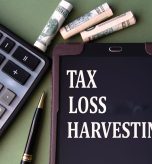As the year draws to a close, many investors focus on maximizing their returns — but the smartest ones also focus on minimizing their taxes. One of the most powerful (and often underused) tools for doing this is tax-loss harvesting.
This strategy can help offset your capital gains, reduce your overall tax bill, and position your portfolio for long-term success. Let’s break down what it is, how it works, and when it makes sense — with some practical examples and CPA-backed insights.

What is Tax-Loss Harvesting?
Tax-loss harvesting is a tax optimization strategy where you sell investments at a loss to offset capital gains from other investments. Essentially, you’re using your losses to lower your tax liability.
When you sell a stock, mutual fund, or ETF for more than you paid, you have a capital gain. When you sell it for less, you incur a capital loss. The IRS allows you to use those losses to offset gains — and in some cases, even reduce your taxable income.
If your losses exceed your gains, you can use up to $3,000 ($1,500 if married filing separately) to offset ordinary income, such as wages or business income. Any additional losses can be carried forward to future years.
How it Works (With an Example)
Let’s say you sold a few winning stocks this year:
- You made $8,000 in capital gains.
- You also have a few underperforming investments with $5,000 in unrealized losses.
If you sell those loss-making investments before year-end, you can offset $5,000 of your gains, meaning you’ll only pay capital gains tax on $3,000 instead of $8,000.
If you had no gains this year, you can still use up to $3,000 of those losses to reduce other taxable income — and carry forward the rest for future years.
It’s a smart, legal way to reduce your tax burden while maintaining a well-balanced portfolio.
Key Rules You Need to Know
- The Wash-Sale Rule
The IRS prohibits you from claiming a tax loss if you buy the same (or “substantially identical”) security within 30 days before or after the sale.
So, if you sell a stock at a loss on December 10, you can’t buy it (or an identical ETF tracking the same index) back until January 9 without forfeiting the deduction.
CPA Tip: Consider buying a similar — but not identical — investment to maintain market exposure without triggering the wash-sale rule.
- Short-Term vs. Long-Term Gains
Losses offset gains of the same type first — short-term with short-term, and long-term with long-term.
Short-term gains (from assets held for under a year) are taxed at your ordinary income rate, while long-term gains enjoy lower rates. Managing both smartly can optimize your after-tax returns.
- Timing Is Everything
You must sell the investment before December 31 for it to count in the current tax year. Waiting until January means you’ll have to wait another year to see the benefit.
When to use Tax-Loss Harvesting
Tax-loss harvesting isn’t about chasing losses — it’s about strategic timing. It’s most effective when:
- You have significant capital gains from other investments this year.
- You expect to stay in the same or higher tax bracket next year.
- You want to rebalance your portfolio without increasing your tax bill.
- You’ve accumulated carryover losses from previous years that can still be used.
If your portfolio is diversified and your long-term goals are clear, harvesting losses can free up cash to reinvest and strengthen your position heading into the new year.
The Long-Term Benefits of Tax-Loss Harvesting
Beyond the immediate tax savings, this strategy also provides long-term financial advantages:
- Improved after-tax returns: Lower taxes mean more money compounding in your investments.
- Portfolio discipline: It encourages regular review and rebalancing.
- Flexibility: You can reinvest the proceeds into similar assets and maintain your overall strategy.
- Loss carryforwards: Unused losses can reduce taxes for future gains.
At Empyrean CPAs, we often combine tax-loss harvesting with strategic year-end planning — ensuring our clients maximize every available deduction and credit.
If you found this concept useful, you might also enjoy our blog on The Power of Tax Planning: A Year-Round Strategy for Maximum Savings, where we explore how proactive planning can make tax season predictable — not painful.
Common Mistakes to Avoid
Even though tax-loss harvesting is powerful, it can backfire if done incorrectly. Here are some pitfalls to watch for:
- Violating the wash-sale rule — leading to disallowed losses.
- Selling too early — missing potential long-term recovery.
- Over-harvesting losses — resulting in an unbalanced portfolio.
- Neglecting transaction costs — small fees can eat into your savings.
A professional CPA can help you navigate these nuances and determine whether harvesting losses makes sense for your unique situation.
Tax-Loss Harvesting and Business Owners
This strategy isn’t just for individual investors. Small business owners who also invest personally can benefit too.
If your business is structured as an S-Corp or LLC, understanding your total taxable income across both business and personal sources is key. Combining strategic tax-loss harvesting with business deductions can dramatically improve after-tax income.
To learn more about the most tax-efficient entity structures, read our guide on S-Corp vs. LLC: Which Entity Saves You More on Taxes?
When Tax-Loss Harvesting May Not be Worth it
In some cases, harvesting losses can do more harm than good. For example:
- If your portfolio is small, the transaction fees may outweigh the tax savings.
- If you’re in a low tax bracket this year but expect higher income next year, waiting might yield better results.
- If you’re selling long-term investments just to create losses, it might disrupt your long-term compounding potential.
As always, context matters more than concept — and this is where a CPA’s expertise can ensure every move aligns with your overall financial strategy.
Final Thoughts: Smart Planning Beats Last-Minute Decisions
Tax-loss harvesting isn’t about timing the market — it’s about timing your taxes.
Before December 31, take time to review your portfolio with your CPA or financial advisor. Identify underperforming investments, check your gains and losses, and consider strategic moves that can reduce your tax liability.
At Empyrean CPAs, we specialize in proactive tax planning that goes beyond annual filing. Whether it’s helping clients harvest losses, optimize cash flow, or structure their business for tax efficiency, our goal is to turn financial complexity into clarity.







